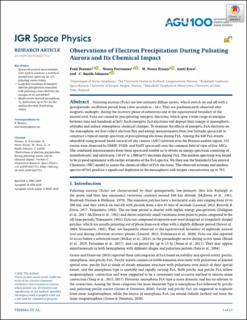| dc.contributor.author | Kebede, Fasil Tesema | |
| dc.contributor.author | Partamies, Noora | |
| dc.contributor.author | Tyssøy, Hilde Nesse | |
| dc.contributor.author | Kero, Antti | |
| dc.contributor.author | Smith-Johnsen, Christine | |
| dc.date.accessioned | 2021-04-28T09:13:15Z | |
| dc.date.available | 2021-04-28T09:13:15Z | |
| dc.date.created | 2020-07-22T14:55:04Z | |
| dc.date.issued | 2020 | |
| dc.Published | Journal of Geophysical Research (JGR): Space Physics. 2020, 125 (6), . | |
| dc.identifier.issn | 2169-9380 | |
| dc.identifier.uri | https://hdl.handle.net/11250/2740098 | |
| dc.description.abstract | Pulsating auroras (PsAs) are low‐intensity diffuse aurora, which switch on and off with a quasiperiodic oscillation period from a few seconds to ∼10 s. They are predominantly observed after magnetic midnight, during the recovery phase of substorms and at the equatorward boundary of the auroral oval. PsAs are caused by precipitating energetic electrons, which span a wide range of energies between tens and hundreds of keV. Such energetic PsA electrons will deposit their energy at mesospheric altitudes and induce atmospheric chemical changes. To examine the effects of energetic PsA electrons on the atmosphere, we first collect electron flux and energy measurements from low‐latitude spacecraft to construct a typical energy spectrum of precipitating electrons during PsA. Among the 840 PsA events identified using ground‐based auroral all‐sky camera (ASC) network over the Fennoscandian region, 253 events were observed by DMSP, POES, and FAST spacecraft over the common field of view of five ASCs. The combined measurements from these spacecraft enable us to obtain an energy spectrum consisting of nonrelativistic and relativistic (30 eV to 1,000 keV) electrons during PsA. The median spectrum was found to be in good agreement with earlier estimates of the PsA spectra. We then use the Sodankylä Ion‐neutral Chemistry (SIC) model to assess the chemical effect of PsA electrons. The observed extreme and median spectra of PsA produce a significant depletion in the mesospheric odd oxygen concentration up to 78%. | en_US |
| dc.language.iso | eng | en_US |
| dc.publisher | Wiley | en_US |
| dc.rights | Navngivelse-Ikkekommersiell 4.0 Internasjonal | * |
| dc.rights.uri | http://creativecommons.org/licenses/by-nc/4.0/deed.no | * |
| dc.title | Observations of Electron Precipitation During Pulsating Aurora and Its Chemical Impact | en_US |
| dc.type | Journal article | en_US |
| dc.type | Peer reviewed | en_US |
| dc.description.version | publishedVersion | en_US |
| dc.rights.holder | Copyright 2020. The Authors. | en_US |
| dc.source.articlenumber | e2019JA027713 | en_US |
| cristin.ispublished | true | |
| cristin.fulltext | original | |
| cristin.qualitycode | 2 | |
| dc.identifier.doi | 10.1029/2019JA027713 | |
| dc.identifier.cristin | 1820204 | |
| dc.source.journal | Journal of Geophysical Research (JGR): Space Physics | en_US |
| dc.source.40 | 125 | |
| dc.source.14 | 6 | |
| dc.relation.project | Norges forskningsråd: 223252 | en_US |
| dc.relation.project | Norges forskningsråd: 287427 | en_US |
| dc.identifier.citation | Journal of Geophysical Research: Space Physics. 2020, 125 (6), e2019JA027713. | en_US |
| dc.source.volume | 125 | en_US |
| dc.source.issue | 6 | en_US |

